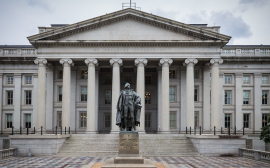Description
The Freedman's Saving and Trust Company, known as the Freedman's Savings Bank, was a private savings bank chartered by the U.S. Congress on March 3, 1865, to collect deposits from the newly emancipated communities. Within 7 years of its formation, the bank opened 37 branches across 17 states and the District of Columbia and collected funds from over 67,000 depositors. At the height of its success, the Freedman's Savings Bank held assets worth more than $3.7 million in 1872 dollars, which translates to approximately $80 million in 2021. However, the rapid development of the bank was largely driven by false claims and was coupled with mismanagement and fraud. The bank failed in 1874, and a contributing factor to this was speculative loans issued by the bank's white officials throughout its existence. There is a consensus among historians that the bank's failure not only affected the savings of many African Americans, but also their trust in financial institutions.
The archives of the Freedman's Savings Bank provide unique information regarding a large share of its depositors. The registers of signatures cover 28 branches from 1865 to 1874 and include information on depositors’ identity, age, occupation, complexion, place of birth and also relatives.
Establishment
At the end of the American Civil War, the poor economic conditions of the formerly enslaved freedmen were aggravated by the economic devastation of the Southern states. The newly freed Blacks had few economic resources or capital and even less exposure to private enterprise. Many soon turned to sharecropping and forced labor in the South. To help alleviate their socio-economic conditions, the Republican-controlled U. S. Congress established the Freedmen's Bureau, passing an act of incorporation and a charter for the Freedman's Saving and Trust Company, which was signed into law by President Abraham Lincoln on March 3, 1865 (13 Stat. 510).
The founder of the Freedman's Savings Bank, John W. Alvord, was inspired by the success of existing military savings banks. These military banks were created during the Civil War to collect the wages of Black soldiers. General Rufus Saxton established the first one in Beaufort, South Carolina, in 1864. Other examples include a bank in Norfolk, Virginia, established by General Benjamin Butler in late 1864, and a bank in Louisiana created by General Nathaniel Banks.
Many former slaves were liberated by the Union Army and were paid to join the army. Troops earned a little cash from their enrollment and participation, and Freedman's became the first banking entity to include them. Most accounts held between $5 and $50.
From 1865 to 1868, the expansion of the Freedman's Savings Bank was largely driven by the money collected from Black soldiers. In the bank's first year, in 1865, two of the branches established were created through the transfer of existing local military savings institutions. Many other branch locations were chosen specifically based on the local Black soldier population. Bank officials made efforts to build the bank legitimacy and deposits raising part of the Black soldiers’ wages. For example, many cashiers at branches also worked as military disbursing officers.
Fraud and other financial misconduct
From the Freedman's Savings Bank's creations, there were several issues in the governance and management that contributed to its ultimate collapse.
Since inception, the bank trustees had little incentive to govern. All fifty original trustees were White and were not required to give "any security for the faithful discharge of their trust."[4]: 8 Many trustees had little to no involvement with the bank, with some even saying that they had never agreed to be part of the board. In addition, the charter that established the bank contained no penal clauses to bind officials and as a result, trustees were not personally liable for the condition of the bank.
The charter establishing the bank was ambiguous about how deposits could be used, with the exception of a very clear rule prohibiting lending, until the amendment of 1870.[4]: 120 While two-thirds of the bank's deposits were required to be invested in U.S. government securities, the remaining available funds did not have specific restrictions. Osthaus wrote of this particular fact that it was “somewhat disquieting to those familiar with the history of savings banks, for they knew that available funds frequently became unavailable”.[4]: 8 One instance of the bank explicitly going against its charter was the investment of funds in the bonds of the Union Pacific and Central railroads in early 1869.
In addition to these, there is historical evidence that the bank's management misled depositors about a supposed government guarantee, interest payments, and the use of the deposit funds.[4]: 56 During the initial years, the bank initiated a marketing campaign in order to promote the bank and attract deposits. This included using churches and Freedmen's Bureau schools to distribute bank pamphlets and other marketing material, advertising through local newspapers, and holding public meetings at churches, beneficial societies, and the bank's branches.[4]: 117 These marketing materials often depicted the bank as having the financial support and guarantee of the federal government, even while the bank was a private corporation with no government guarantee. An example of this is an article in the Semi-Weekly Louisianan which stated that “there is no possibility of loss, for the reason that the government of the United States is responsible for every dollar deposited.”[4]: 56 In addition, an interest rate of 6% was proposed to depositors; however, in many instances of the bank's history, depositors received a lower rate of return on their depositors.
A series of increasingly speculative investments caused the bank to accumulate bad debt, while the decision to build a new building in Washington, D.C., added to its financial troubles. On May 2, 1870, the bank managed to obtain the authorization from Congress to make loans backed by real estate. However, only half of the deposit funds could be used for real estate loans, and these loans were to be secured by mortgages that were double the value of the loan.
The bank's investments often violated the bank's charter and its amendment. One example is loans totaling approximately $50,000 made to the Seneca Sandstone Company, the owner of the Seneca Quarry, secured by “the company's worthless bonds”.[4]: 154 The loan was approved by Henry D. Cooke, the head of the bank's finance committee, who sat on the board of the quarry company. Bank officials also approved personal loans to themselves as well as associates of the bank. For instance, loans totaling $224,000 were made to Robert I. Fleming, who was the contractor for the bank's building in Washington, D.C. Even as the failure of the bank was imminent and depositors were refused from being able to withdraw their deposits, a secret loan of $33,366.66 was made to Juan Boyle by the actuary George L. Stickney on June 30, 1874.[2] Other instances include investments in the bonds of the Union Pacific and Central Railroads made as early as 1869.
The bank's management closely linked the bank's affairs to the investment bank Jay Cooke and Company, which invested heavily in railroads. As head of the finance committee of the bank, Henry D. Cooke, Jay Cooke’s brother, deposited a significant share of the cash of the Freedman’s Savings Bank at the First National Bank in Washington, D.C., which was Jay Cooke’s office. This amount at its highest was $500,000, on which the Cooke brothers paid a 5 percent interest, even while the Freedman’s Savings Bank was promising 6 percent to its own depositors.
Failure
When the Panic of 1873 struck, several railroad projects failed, which undermined the financial situation of the Freedman's Savings Bank. This led to a series of runs in different branches.
Following the panic, in an attempt to restore confidence in the bank among the African-American community, there was a significant change in the leadership of the bank. Trustees of the bank deposed the founder and president John W. Alvord in March 1874, and elected in favor of Frederick Douglass as president.[4]: 184 Of this change in leadership, Walter Lynwood Fleming remarked: “Some, looking for a scapegoat, were anxious that colored officials be in charge when the bank failed as they were sure it would; others thought that a Negro administration would restore the confidence of the depositors and enable the institution to survive until better times."
The bank closed on July 2, 1874, despite the reform attempt. Some scholars claim that the failure of the Freedman's Bank and the loss of their savings led to a distrust of all banking institutions for several generations among the Black community.
Depositors’ losses
Just after the collapse, in July 1874, three commissioners were appointed to wind down the bank. They found that the value of assets was lower than what was registered in the bank books as of July 1874. In addition, liquid assets, cash and government securities, were less than 2% of the total liabilities the bank held.
Many depositors never received their deposits back after the bank failed. To repay them, the commissioners decided to rely on personal passbooks only, instead of the bank books. Therefore, depositors needed to mail their passbooks to Washington to submit their claim. Many depositors, who had lost faith in the bank, were reluctant to do so. Others faced legal challenges in proving their identities or their relationship to depositors who had died. Some who did receive checks did not cash them as they were unaware about what their checks were.
The repayments came late, with adverse consequences for depositors facing severe personal cash shortfalls. Not until November 1875 did the bank start returning a proportion of the deposits. The commissioners, even in the face of many special requests made by depositors to obtain small amounts of cash, instructed cashiers at branches to not advance any money even in the case of extreme necessity as a matter of bank policy. In response to this, some depositors, who had lost faith in the bank and were in dire need of funds sought to sell their claims against the Freedman's Savings Bank at a discount. Some were even selling their passbooks to grocers and other store owners in order to receive groceries and other supplies.[4]: 205 On many occasions, the discount that depositors received for their claims was steep. For example, an account holder at the New Orleans branch, in 1881, surrendered his $352 deposit for just $28.16. On the first dividend announcement, only 49% of eligible depositors requested a payment, and bank statistics showed that these were largely claims from the wealthier depositors.[4] Account holders who had only small balances collected little to no funds. The delayed payments as well as the limited share of depositors receiving them suggest that, on average, depositors received far less than 62% of their deposits.
Archives
The surviving documentation and papers of the bank archives illuminate the names, whereabouts and other relevant information about the veterans of the 7th Regiment United States Colored Troops and their transactions with the bank; the data is considered historically important in the study of African American history. The bank's records of 480,000 names, estimated to be the largest single repository of lineage-linked African American records, has been indexed by The Church of Jesus Christ of Latter-day Saints. The searchable database is available to amateur and professional genealogists as well as researchers.























